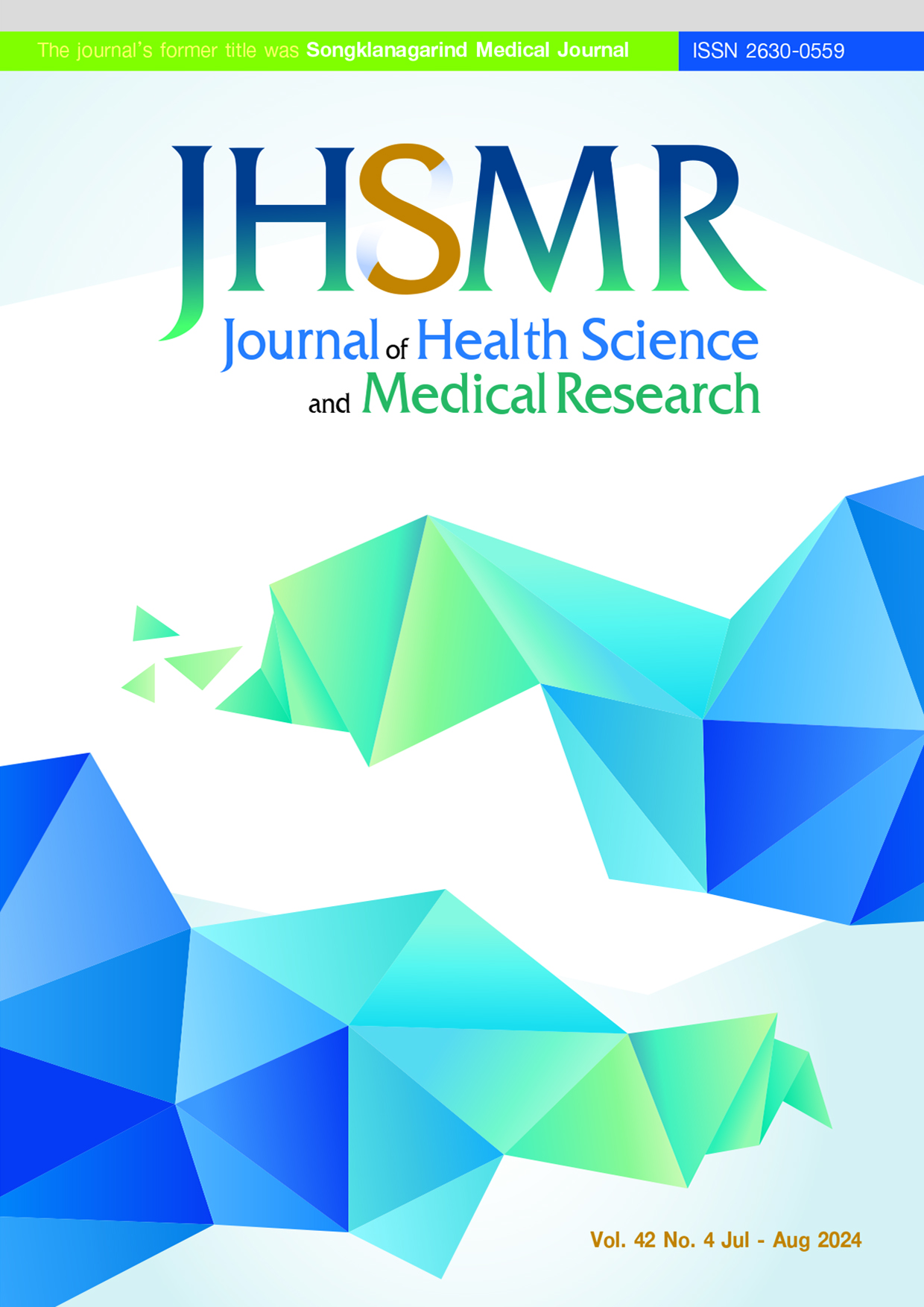Incidence of Extravasation during Norepinephrine Administration via Peripheral Venous Catheter in Emergency Patients
DOI:
https://doi.org/10.31584/jhsmr.20241039Keywords:
emergency department, extravasation, norepinephrine, peripheral vein vasopressorAbstract
Objective: To describe the incidence of extravasation resulting from the administration of norepinephrine through a peripheral venous catheter in emergency patients.
Material and Methods: This prospective observational study was conducted on 150 adult patients in the emergency department at Siriraj Hospital, Thailand. Physicians closely monitored patients who received norepinephrine via a peripheral venous catheter examining the intravenous access sites during the period of treatment and for up to 48 hours after discontinuation of treatment. We collected demographic data, norepinephrine administration details, potential risk factors for extravasation, the incidence of extravasation, and mortality rate.
Results: The median age of the patients was 67 years, and 60.7% were male. Most patients (93.3%) received peripheral intravenous norepinephrine for septic shock, administered below the wrist joint (47.3%) through a 22-gauge catheter (82.7%). The median duration of total peripheral intravenous norepinephrine administration was 19.92 hours (interquartile range (IQR) 9.48-38.09). The median maximum dose was 0.07 mcg/kg/min (IQR 0.04-0.10). Extravasation occurred in three patients (2.0%) (95% CI: 0.6 - 6.1), none of which resulted in significant morbidity. The timing from shock diagnosis to peripheral intravenous norepinephrine administration did not statistically differ between survivors and non-survivors at both 7 and 30 days. However, the median time from shock diagnosis to achieve mean arterial pressure (MAP)≥65 mmHg, and time from norepinephrine administration to achieve MAP ≥65 mmHg, was shorter in the survivors compared to the non-survivors.
Conclusion: Given that the incidence of extravasation events was low and did not result in significant morbidity, we suggest that peripheral intravenous norepinephrine administration is safe under close observation and for a limited duration.
References
Evans L, Rhodes A, Alhazzani W, Antonelli M, Coopersmith CM, French C, et al. Surviving sepsis campaign: international guidelines for the management of sepsis and septic shock 2021. Crit Care Med 2021;49:e1063-143.
Angkasekwinai N, Rattanaumpawan P,Thamlikitkul V. Epidemiology of sepsis in Siriraj hospital 2007. J Med Assoc Thai 2009;92:68-78.
Li Y, Li H, Zhang D. Timing of norepinephrine initiation in patients with septic shock: a systematic review and meta-analysis. Crit Care 2020;24:488.
Tian DH, Smyth C, Keijzers G, Macdonald SP, Peake S, Udy A, et al. Safety of peripheral administration of vasopressor medications: a systematic review. Emerg Med Australas 2020;32:220-7.
Siriraj Hospital Drug Control and Care Committee. Standard Operating Procedures for High Alert Drugs. 4th Edition. Bangkok: April 2017;128-31.
Medlej K, Kazzi AA, El Hajj Chehade A, Saad Eldine M, Chami A, Bachir R, et al. Complications from administration of vasopressors through peripheral venous catheters: an observational study. J Emerg Med 2018;54:47-53.
Infusion Nurses Society. Infusion nursing standard of practice. J Infus Nurs 2006;29:1-92.
Rodriguez-Calero MA, Blanco-Mavillard I, Morales-Asencio JM, Fernandaz-Fernandez I, Castro-Sanchez E, Pedro-Gomez JE. Defining risk factors associated with difficult peripheral venous cannulation: a systematic review and meta-analysis. Heart Lung 2020;49:273-86.
Beck V, Chateau D, Bryson GL, Pisipati A, Zanotti S, Parrillo JE, et al. Timing of vasopressor initiation and mortality in septic shock: a cohort study. Crit Care 2014;18:R97.
Bai X, Yu W, Ji W, et al. Early versus delayed administration of norepinephrine in patients with septic shock. Crit Care 2014;18:532.
Loubani OM, Green RS. A systematic review of extravasation and local tissue injury from administration of vasopressors through peripheral intravenous catheters and central venous catheters. J Crit Care 2015;30:e9-17.
Lewis T, Merchan C, Altshuler D, Papadopoulos J. Safety of the peripheral administration of vasopressor agents. J Intensive Care Med 2019;34:26-33.
Cardenas-Garcia J, Schaub KF, Belchikov YG, Narasimhan M, Koenig SJ, Mayo PH. Safety of peripheral intravenous administration of vasoactive medication. J Hosp Med 2015;10:581-5.
Nguyen TT, Surrey A, Barmaan B, Miller S, Oswalt A, Evans D, et al. Utilization and extravasation of peripheral norepinephrine in the emergency department. Am J Emerg Med 2021;39:55-9.
Permpikul C, Tongyoo S, Viarasilpa T, Trainarongsakul T, Chakorn T, Udompanturak S. Early use of norepinephrine in septic shock resuscitation (CENSER). A randomized trial. Am J Respir Crit Care Med 2019;199:1097-105.
Downloads
Published
How to Cite
Issue
Section
License

This work is licensed under a Creative Commons Attribution-NonCommercial-NoDerivatives 4.0 International License.
























